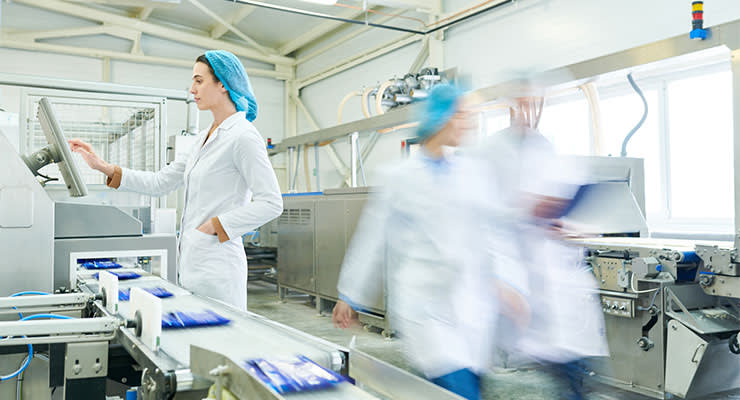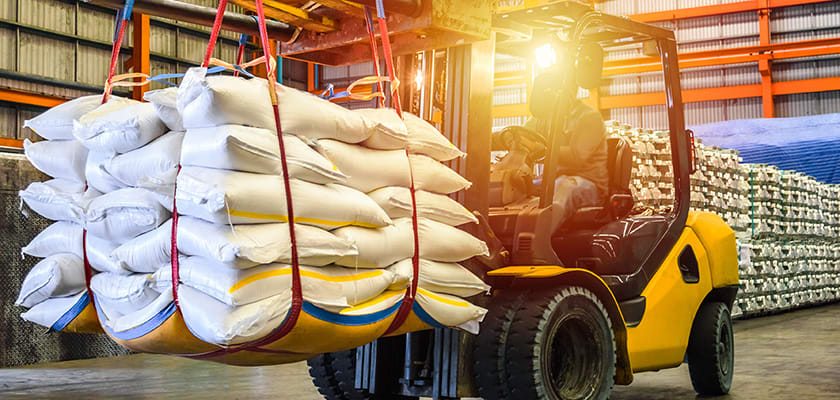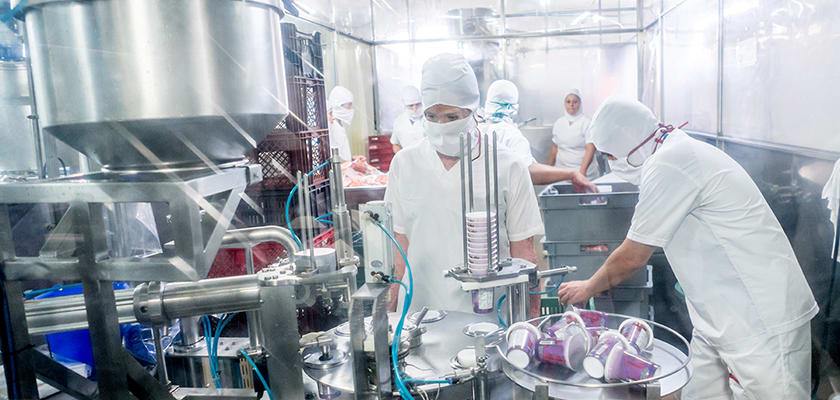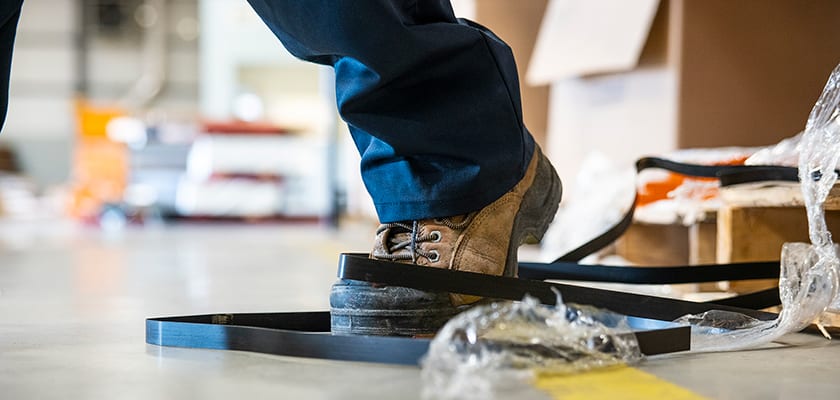Top hazards in food manufacturing: Protect your workplace and team with these safety resources

Workplace Safety & Prevention Services (WSPS) is a not-for-profit occupational health and safety association committed to ensuring every worker goes home healthy and safe at the end of the day. As your dedicated health and safety association for the food manufacturing industry, we are here to help with resources and support.
The food manufacturing industry and partners are working with WSPS to develop solutions that address the top risks in this sector. In a recent study, this group identified the top 10 risks in the food manufacturing industry. Find out what these risks are and how you can protect your business with these resources below.
Top 10 risks in food manufacturing: Resources and training
Click on a hazard to learn more and access health and safety resources and training.
- Inadequate lockout/tag out of equipment
- Mobile equipment incidents
- Bypassing safeguarding on equipment
- Slips, trips, and falls
- Inadequate safeguarding of equipment
- Loading/unloading trailers
- Musculoskeletal disorders
- Electric rider pallet truck incidents
- Struck by mobile equipment
- Temporary workers
Have health and safety questions? We're here to help. Contact us at 1-877-494-9777 or fill out this form and a member of our team will contact you soon.
Inadequate lockout/tag out of equipment

Lockout/tagout is the process of isolating the equipment from its energy source, draining the equipment of any energy that may be stored, and applying locks to secure it in a de-energized state. This allows you to safely interact with the equipment to clean, maintain and service it or remove jams or blockages. Improper lockout/tagout can lead to contact with dangerous energy. To be effective, a lockout program needs clear procedures, proper training, and supervision.
Resources
- Lockout/tagout Training Guide
- Lockout/tagout - Staying Safe with Hazardous Energy Guides (Printable PDF) - Learn lockout tagout best practices and how to reduce risks for each role in the workplace. These guides are available for employers, supervisors and workers.
- Top 10 Root Causes of Inadequate Lockout Tagout in Food Manufacturing (infographic)
- Staying safe with hazardous energy: Using the Lockout Tagout procedure (video)
- Safety in 60 Seconds: Safety tips on lockout/tagout (video series)
- Lockout/tag out: Do it right with these expert tips (article)
- Protect your team from the top hazard in food manufacturing: Tips to prevent lockout/tag out incidents (article)
- Lockout/tagout: How to identify a machine's energy sources, and when to use the ‘Left-Hand Rule (article)
- Effective lockout training: 9 proven ways to get workers listening and learning (article)
Training and consulting
- Lockout Tagout (eCourse)
- Lockout Tagout Safety Essentials (online, instructor-led, 0.5 day)
- Electrical Hazards (eCourse, 1 hour)
- Machine Safety & Robotics Consulting - WSPS machine safety and robotics experts can improve your understanding of the hazards and their associated risks in your workplace. We will work with you to identify effective safeguarding options to protect worker safety.
Mobile equipment and pallet truck safety

In a fast-paced manufacturing environment, workers share space with different mobile equipment including forklifts, manual pallet jacks, electric pallet jacks, lift trucks, cranes, and trucks. To keep workers safe, ensure these elements are considered in your safety plan:
- Powered Mobile Equipment and Pedestrian Safety. Mobile equipment like lift trucks and vehicles working near pedestrians can put workers at risk. These risks can lead to serious injuries or death. These incidents can also cause property damage, downtime, and expensive fines for your business.
- Loading Docks. Loading docks are often crowded with equipment, goods, and people. They can be exposed to weather and are usually in tight, dimly lit spaces, which can cause injuries and property damage.
- Loading and Unloading Trailers. Loading and unloading trailers have unique risks, such as falling from the dock due to trailer movement, early departure, or breaking through weak trailer floors. These can result in worker injuries or fatalities.
Use the resources below to learn more about building or updating your traffic management and pedestrian safety plan.
Resources
- NEW! Mobile Equipment & Pedestrian Safety: Safety Technologies Guide
- 8 steps to keep lift truck operators and pedestrians safe (article)
- 6 steps to implement a traffic management plan (article)
- Worker resources: Safety around forklifts, cars, vans and trucks (video or article)
- Guide to workplace traffic management (Safe Work Australia)
- Material Handling in Food and Beverage Wholesale Distribution (video)
- Safety in 60 Seconds: What are the fundamentals of a strong traffic management assessment and program? (video)
- Vehicle & Pedestrian Safety (video)
- Mechanical Material Handling Q&A: Your questions answered (article)
- Protect warehouse workers from struck by incidents: Real life examples and expert tips (article)
- Prevent struck by incidents: 3 expert tips to keep workers safe (article)
- 8 tips for managing external traffic
- Nip point incident offers 6 lessons for workplaces (article)
- Inspecting robot systems: 7 ways to boost JHSC performance (article)
- Worker Resource: Loading and Unloading Trailers Safely (article and video)
- Safety in 60 Seconds: Safety tips - What should employees know about loading and unloading a truck or trailer safely? (video)
- Warehouse Safety Tips - Assess Your Warehouse Risks (video)
- Loading Docks and Warehouses (guide)
- Warehouse Safety Tips - Assess Your Warehouse Risks (video)
Safety Checklists
- Working Around Traffic
- Visibility Hazards Checklist
- Reach Truck/Order Picker Safety
- Storage Rack Safety
- Forklift Safety Check
Safeguarding and machine safety

The workplace is filled with moving parts—gears, conveyors, cogs, spindles, and pulleys. Each of these components poses significant hazards to workers if machines are not properly safeguarded during operation or locked out during maintenance. These dangers can lead to severe injuries, such as limb amputations or even fatalities, and can result in substantial costs for employers.
Hazard prevention programs should review machine guarding, conduct pre-shift inspections, follow specific lockout procedures, and measure program effectiveness. They should also clearly define responsibilities and refer to safety laws and standards.
Find out how safeguarding machinery can protect your team with the resources below.
Resources
- NEW! Effective Safeguarding: Best Practices and Insights (guide)
- Pre-Start Health and Safety Review (PSR) Checklist for: New Equipment
- Pre-Start Health and Safety Review (PSR) Checklist for Modified Equipment
- Pre-Start Health and Safety Review (PSR) Frequently Asked Questions
- Operating machines safely: 4 obstacles and tips to overcome them (article)
- Worker resource: Working safely with machines (video and article)
- Safety Tips: Machine safeguarding (video)
- Safety Tips: Assess your safeguarding in four easy steps (video)
- Recent tragedies put the spotlight on conveyor safety: 5 steps you should know (article)
- Safety in 60 Seconds: Pre-start health and safety reviews (PSRs) (video series)
- Mechanical Safeguarding Poster: MAC & AUTO (infographic poster)
- Top 6 Root Causes of Mobile Equipment Incidents and Bypassing/Inadequate Safeguarding in Food Manufacturing (infographic)
- Machine safety guide
- Safety Check: Meat Band Saw Safety (guide)
- 6 things you need to know about PSRs (article)
- Guideline for pre-start health and safety reviews (Ministry of Labour, Immigration, Training and Skills Development)
Training and consulting
- Managing Machine Safety (3.5 hours, online instructor-led training)
- Safeguarding of Machinery: Understanding and Applying CSA Z432 (1 day, Online Instructor-Led Training)
- Managing Pre-Start Reviews (half day, online instructor-led training)
- Machine Safety & Robotics Consulting - WSPS machine safety and robotics experts can improve your understanding of the hazards and their associated risks in your workplace. We will work with you to identify effective safeguarding options to protect worker safety.
Slips, trips and falls

Slips, trips, and falls are common workplace injuries. A good housekeeping program, including quick spill clean-ups, can help reduce the risk of injury.
Working at heights, including the use of ladders and mobile access platforms, can also pose significant risks in the workplace. Develop effective work plans, policies, and programs with input from key stakeholders, including workers. This collaboration ensures safe practices are developed, applied, and maintained, which is critical for reducing risks.
Resources
- Stop slips, trips and falls with these expert tips (article)
- Falls from under 3-metres can be fatal: how to prevent them (article)
- Slips, Trips, and Falls Overview (article)
- Ladder Safety (guide)
- Safety Check: Mopping Spills Safety (guide)
- Safety Check: Step Ladder Safety (guide)
- Mobile Ladder Stands or Mobile Ladder Platforms (guide)
- Working at Heights Regulation and Information (article)
- Housekeeping Overview (article)
- Overview: Working at Heights Regulation and Information
- Preventing slips, trips, and falls in the workplace (Ministry of Labour, Immigration, Training and Skills Development)
Training
- Preventing Falls from Slips and Trips (1 hour self-paced eCourse)
- Ladder Safety Training (1 hour self-paced eCourse)
- Working at Heights (an Introduction) (1 hour, self-paced eCourse)
Musculoskeletal disorders

Materials handling is common in workplaces, done either manually or with lifting equipment. Manual material handling involves lifting, lowering, pushing, pulling, holding or carrying materials from one place to another and can lead to overexertion and musculoskeletal disorders (MSDs). MSDs are different aches and pains affecting the musculoskeletal system (muscles, tendons, and nerves) and make up almost half of all compensation claims in Ontario. Common MSDs include back pain, carpal tunnel syndrome, and tendonitis.
Use the resources below to build a safety program that addresses these hazards to keep your business running smoothly.
Resources
- Safe lifting: 10 tips and videos of how to lift properly (article)
- How to eliminate 3 hidden causes of musculoskeletal disorders (MSDs) (article)
- Back to basics: Answers to your questions about manual material handling and MSDs (article)
- How to identify and prevent repetitive strain injuries (article)
- MLITSD material handling inspections on now: be prepared (article)
- Safety Tips - Manual Material Handling and Safe Lifting (video series)
- Musculoskeletal Disorders (video)
- MSD Risk Assessment (guide)
- MSD Hazards Checklist
- Business in Motion: Managing Material Handling Hazards (guide)
- Manual Material Handling and Musculoskeletal disorders (MSDs) Job Aid
- MLITSD Material Handling Inspections - Frequently Asked Questions
- Safe Lifting / Preventing musculoskeletal disorders or MSDs
- Non-motorized Material Handling Equipment Checklist
- MSD Prevention Guideline for Ontario (CRE-MSD)
- Guidelines for Supervisors - Ensuring Safe Lifting and Manual Material Handling in the Workplace Information Guide
- Manual Material Handling - Mobile Ladder Stands or Mobile Ladder Platforms checklist
Training and consulting
- Manual Materials Handling (eCourse, 1 hour)
- Safe Lifting & Manual Materials Handling (1/2 day, online instructor-led training)
- Safe Lifting & Manual Materials Handling - Supervisor (1 hour, online instructor-led training)
- Manual Materials Handling (1 hour, eCourse)
- Musculoskeletal Disorders (MSD) Prevention Awareness (1 hour, eCourse)
- Ergonomics Consulting - WSPS experts will work with you and your staff to find personalized, cost-effective solutions to improve your work environment, protect your employees and your bottom line.
New and temporary workers

Labour shortages and seasonal demand mean more businesses are relying on new and temporary workers. A new worker is:
- any new hire, permanent or temporary, including supervisors, with or without industry experience
- current workers assigned to new jobs
- student workers, co-op placements, or apprentices
- contract workers
A strong orientation program is key to keeping new and temporary workers safe in your workplace. Start strengthening your safety training with tips from the resources below.
Resources
- New temporary help agency licensing requirements: How do they impact your business? (article)
- Vulnerable Workers Health and Safety Awareness (article)
- New Worker Orientation Checklist
- Template - Worker Orientation
- Hiring foreign workers? Here’s how to onboard them safely (article)
- 5 tips to protect the health and safety of new Canadians (article)
- Share with your workers: Manufacturing safety resources available in 6 languages (article)
- Strengthen your orientation and training program to get results (article)
- Employee Orientation and Training Checklist
- Health and Safety Handbook Generator
- New Worker Orientation Guide
- Safety in 60 Seconds: What is the best way to train new and young workers? (Video)
Training
- Worker Health and Safety Awareness Training – Free mandatory training from the Ministry of Labour, Immigration, Training and Skills Development.
- Orientation on Health and Safety for New Workers (eCourse, 1.5 hours)
- Managing Hazards & Risks (3.5 hours, Online Instructor-Led eLearning)
- Health and Safety Awareness for Ontario Workers (1 hour, eCourse)
- Orientation on Health and Safety for New Workers (1.5 hours, eCourse)
- Supervisor Responsibilities and Due Diligence (4 hours, Online Instructor-Led eLearning)




